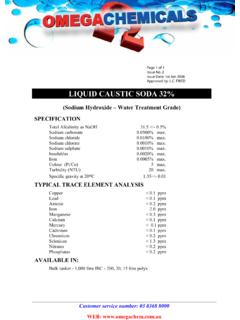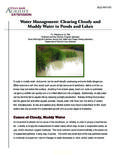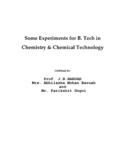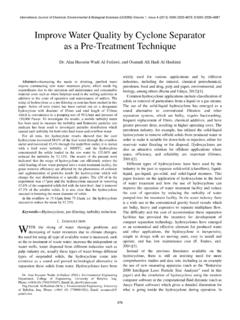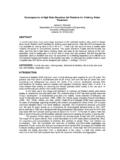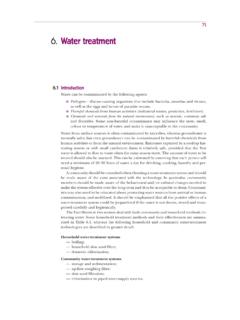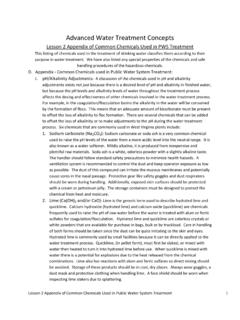Transcription of MEGAPAC 23 - Omega Chemicals
1 MEGAPAC 23 (Aluminium Chlorohydrate) Polyaluminium Hydroxychloride coagulants are becoming increasingly popular in the treatment of municipal water and wastewater. Other applications in the paper making, deodorant and cosmetics industry are also experiencing growth both locally and internationally. The market is experiencing rapid growth in Australia, Japan and the United States. Since commencing production of MEGAPAC 23 (Aluminium Chlorohydrate) in early 1999, Omega Chemicals has fielded many enquiries into the benefits of MEGAPAC 23 over traditional aluminium and iron based coagulants. This brochure provides details of the potential benefits associated with Polyaluminium Hydroxychloride coagulants over traditional coagulants. Lower Dose Rates Compared with alum , MEGAPAC 23 has a higher proportion of active ingredient. The following table compares the concentration of active ingredient on the basis of Al2O3 content: Product Active Ingredient (as wt% Al2O3) pH MEGAPAC 23 23 - 24 3 - 4 Liquid alum - 2 -3 alum powder 17 - 18 2 - 3* * In a 50% solution MEGAPAC 23 has around 3 times as much active ingredient as liquid alum .
2 On this basis alone, MEGAPAC 23 can treat 3 times as much water as an equivalent amount of liquid alum . In reality, many of Omega 's customers that have trialed MEGAPAC 23 have reported that its actual efficiency is between 500 - 600% when compared with liquid alum . This increased efficiency is due to the nature of the aluminium species. Aluminium chloride coagulants such as MEGAPAC 23 contain polynuclear species with up to 13 agglomerated aluminium molecules, yielding a highly cationic charge and enables more efficient flocculation. Flocs are also formed more rapidly improving plant efficiency. The nature of the polynuclear species present in MEGAPAC 23 is determined by the basicity of the product. The basicity is defined as the ratio of chloride groups substituted for hydroxyl groups on the molecule and is typically above 83% for MEGAPAC 23. Customer service number: 03 8368 8000 WEB: Customer service number: 03 8368 8000 WEB: Lower Residual Coagulant Due to lower dose rates in the raw water, MEGAPAC 23 can produce treated water with lower residual coagulant concentration than can be achieved with alum or iron salts.
3 This can result in reduced rates of metal deposition in the distribution system, which can adversely affect treated water quality. Higher pH of Treated Water MEGAPAC 23 has a pH of 3 - 4 compared with a saturated alum solution which is usually in the pH range 2 - 3. Several factors influence the pH of the treated water when MEGAPAC 23 is compared to liquid alum . Use of higher pH coagulants such as MEGAPAC 23 at a dosage rate of one fifth to one sixth of that required for liquid alum yields treated water of greater pH. In addition, MEGAPAC 23 does not consume alkalinity from the solution to form flocs as alum does due to the presence of hydroxyl ions in the molecules. In many cases, MEGAPAC 23 eliminates the need for pH correction of the treated water. Colour Removal Customers of Omega Chemicals have reported that MEGAPAC 23 is significantly more effective in the removal of colour than alum . Reduced Sludge Production Because the need for pH correction of the treated water is reduced or eliminated, the production of sludge can be greatly reduced.
4 This is especially the case where lime is used for pH correction as up to 25% of lime added can remain undissolved and ultimately require disposal as sludge. Where pH correction cannot be totally eliminated, the use of MEGAPAC 23 could improve the economics of changing from lime to more soluble materials such as soda ash or caustic soda, further reducing sludge from lime residue and resulting in lower levels of turbidity in the treated water. In addition, the quantity of coagulant used also influences the quantity of sludge produced. This is more significant where the raw water has low turbidity or the treatment is employed primarily for colour removal. Because MEGAPAC 23 is dosed at a significantly lower rate than alum , the amount of sludge generated should be reduced in these applications. Coagulation Over Wider pH Range Traditional coagulants such as alum and iron salts become less effective when the pH of the raw water exceeds 8 as the cationic charge of the aluminium species is diminished.
5 This can be overcome by overdosing of the coagulant or use of coagulants with high free acidity however this approach could cause an increase in the generation of sludge. High basicity coagulants such as MEGAPAC 23 operate effectively in raw water up to pH 9 as they are able to retain their strong cationic charge. This can be particularly useful in treating raw water where algae is present and causing high pH levels in the raw water. Longer Filter Run Time Literature suggests that flocs formed by coagulants such as MEGAPAC 23 are of a less sticky or gelatinous nature than those formed by alum and iron salts. This results in lower turbidity of the treated water and enables longer filter run times. Customer service number: 03 8368 8000 WEB: This in turn reduces the number of backwashes required and therefore the amount of backwash solids that need to be handled. Fewer backwashes also result in greater overall plant efficiency.
6 More Economic Treatment Although MEGAPAC 23 is more expensive than traditional coagulants such as alum , ferric sulphate and ferric chloride on a per tonne basis, this is offset by other potentially significant savings. These include costs associated with the disposal of sludge, the use of Chemicals to adjust pH, improved plant efficiency and improved quality of the treated water. The greater efficiency of MEGAPAC 23 over alum (up to 600% more water treated) can more than offset the difference in cost. Summary of Benefits of MEGAPAC 23 Lower dosage rates required compared with alum and iron salts resulting in: Lower residual coagulant in the treated water. Reduced sludge in applications where raw water has low turbidity and treatment is primarily to facilitate colour removal. Higher pH of treated water resulting in: Reduction or elimination of need for pH correction. Reduction in sludge production where lime usage is reduced or eliminated.
7 Reduction of overall chemical cost due to: Reduction or elimination of pH correction and associated storage and handling costs. Lower chemical cost than alum or iron salts based on quantity of water treated. No requirement to overdose coagulant in applications with elevated pH. Improved plant efficiency arising from: Longer filter runs due to stability of flocs formed. Reduction in frequency of backwashes, reducing amount of backwash material requiring disposal. Effective over wider range of applications than alum and iron salts: Effective in pH ranges up to 9 whereas alum and iron salts lose effectiveness above pH 8. More effective than alum and iron salts in some applications where algae is a problem. Effective in colour removal. Availability: Industrial Grade Cosmetic Grade (low iron, < 70 ppm) Packaging: Bulk - up to 19,000 litre consignments IBC - 1,000 litre lots Drum - 200 litre polydrums NOTE: If substituting aluminium chloride coagulants such as MEGAPAC 23 for liquid alum , the storage and dosing system should be completely free of alum .
8 This is because mixing with alum can cause the aluminium chloride to decompose to aluminium hydroxide. For further information about MEGAPAC 23, contact our customer service department.

